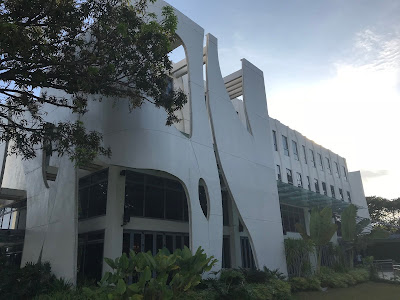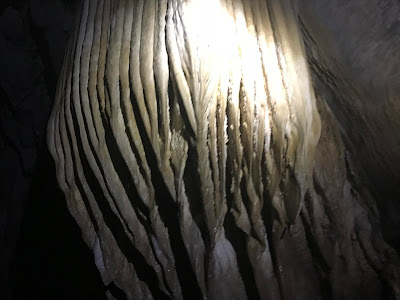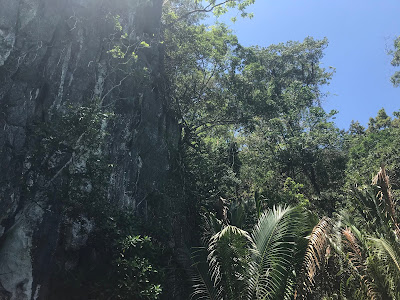 |
| Domestic Terminal at Ninoy Aquino International Airport |
The flight from Manila to Puerto Princesa is less than an hour in the air. It was my first time flying out of the domestic terminal at Ninoy Aquino airport as usually when I go to the Philippines, I stick to the island of Luzon as that’s where Manila and where my relatives are located. (Remember, the Philippines is an archipelago of more than 7,000 islands.) I was pleasantly surprised at how nice the domestic terminal was; it was even better than the international terminal I normally fly out of in that it had more choices for stores and eats. I was dropped off early for my flight as Manila traffic is unpredictable so I had some time to wander around and, okay, yes, I had a waff-wich, also a new experience for me – it’s a tasty waffle sandwiched with the filling of your choice. Not gonna lie – I had two, a savory one (ham and cheese) and a dessert one (chocolate and hazelnut).
The flight was smooth and I had booked my
hotel weeks beforehand. Thanks to recommendations from tripadvisor.com, I found
the Canvas Boutique Hotel which was touted as being mere minutes from the
airport with free shuttle service. And they didn’t lie. The driver came up a
few minutes after I emerged from the airport, loaded me into the shuttle and 3
minutes later, deposited me in the hotel lobby. Couldn’t have been easier.
The hotel was perfect for my purposes. The staff was friendly, the room was spacious and clean (and air conditioned!), there was free wifi and free breakfast in the mornings. I had arranged the tour of the Underground River through them for 2,000 pesos (approximately $40 USD). They took care of booking it and all I had to do was provide my credit card for payment and come down the next morning at the appointed time.
The tour accommodated 10 tourists and we were loaded into a shuttle van along with our driver, Emman (not to be confused with my cousin Emman – Emmanuel is a very common name in the Philippines which is still predominantly a Catholic country), and our tour guide, Dean. Dean was very informative and gave us some history about the Underground River, which is one of the longest navigable underground rivers in the world.
I wasn’t well prepared for the tour as I had been too busy at work to do much prep beforehand. In hindsight, my travel tips for this tour: bring/wear bug repellent (it’s the tropics, after all). If you’re like me and are unprepared, the tour does make one stop before we get to the pick up spot for the Underground River. It’s meant to be a bathroom break, a photo op with beautiful scenery, and a place to pick up snacks, tsotchkes, sunscreen and bug spray. I got an extra bottle of water and bug repellent.
Second tip: wear lots of sunblock with the highest SPF you can find as that tropical sun is no joke (remember, you’re close to the equator) and bring a hat or something for your head. If you forget or aren’t prepared (hello, that’s me), there are a plethora of sellers walking around the Puerto Princesa Underground River Tour pickup selling hats, freshwater pearl jewelry, rosaries and clear plastic pouches for cell phone protection. I bought a hat for 120 pesos ($3). My relatives probably would’ve wanted me to haggle but, hey, I’m a tourist and $3 was cheap for a pretty straw hat.
At the pickup spot, the tour group split into 2 boats and we were ferried across the water to another small island and offloaded onto a stretch of beach. It’s within this that the Underground River starts. Oh and third tip: wear flip flops that you don’t mind getting wet. I completely missed that memo but Dean was kind enough to give me his and went barefoot. Because when you get off the little boat you were ferried in, you go about ankle deep into the water before making your way onto the sandy stretch of beach. Yeah, my leather sandals wouldn’t have done well. I hesitated to take Dean’s flip flops and planned to just go barefoot myself when I left the boat but he insisted and it seemed churlish to refuse when he was so concerned about all of us having a good experience, flip-flopped feet and all.
We did a brief walk, saw a really big-ass lizard (shudder) indigenous to the area and were duly informed to leave the monkeys alone and to be wary of their boldness in snatching at anything plastic bag-like as they’ve learned to equate that with holding food (curse previous tourists who fed them when they shouldn’t have just because they thought they were cute).
The short walk from the beach to the start of the tour was a very beautiful lake where each boat takes 10 passengers and is rowed manually by the guide (not Dean but the Underground River Tour guide, one for each boat). Each passenger is given an audio pack and headphones and the tour can be listened to in a variety of languages. Besides myself, our tour group included 3 young guys from Finland, a Dutch couple, two older Filipino ladies and 2 younger ones in their 20s. Mark, our priority addition, like me, was a tourist from the USA, also Filipino but here for the explicit reason to see his home country as a tourist.
I imagine with 10 people plus the guide in the boat, it’s difficult to navigate and row, especially since most of these guides are not big and bulky. Nevertheless, ours guided us expertly through the Underground River. We entered a cave and from there, were “rowed” or poled (I am extremely ignorant of nautical/sailing/rowing terminology so bear with me) about 1.3 kilometers into the cave and back. The underground river runs longer than that through the various caves but we did the short version as not all of the passages are wide enough to accommodate the boats.
Inside, it’s completely dark, as you would expect from a cave. The guide shines a light in conjunction with what the audio tour is saying as we navigate each part of the cave. There are various stalactites and stalagmites throughout and the tour has a firm religious bent, down to interpreting some of the structures as “the Last Supper” and the nativity. I thought they were interesting rock formations formed over possibly millions of years.
Bats are the natural habitants of the caves and, although it was the sleeping time for most of them, we could hear them, clicking as part of their echo-location way of moving about. We were warned several times that it we were looking up, to keep our mouths closed. Our guide joked that if we felt something wet and cold, that was okay since it was water. If it was warm, that was not okay since it was likely bat guano. Erk.
Fortunately we all had been given helmets to wear to protect our heads in case anything more serious than bat guano dropped on us. These were caves after all. It was all pretty fascinating, gently being rowed down the river and back, seeing the lights sweep over the various cave formations, and seeing what nature had created persistently and patiently over more years than my mind could wrap around. It gives you pause to reflect on all the wonders of nature and the time it took to be created.
Once we emerged from the cave, we were rowed back to the landing then there was a brief wait before we headed back to the beach to be picked up by the boat taking us back to our original docking place. The tour included lunch at a buffet restaurant. Don’t picture it as a Vegas-like casino buffet set up. It was cafeteria, bench-style seating with the food arranged in the middle of the open-air dining room. All of it was local Filipino cuisine, from adobo to pancit inihaw na isda (grilled fish) and lumpia to maja blanca and watermelon for dessert. As Dean told us ahead of time, “it isn’t fancy but it’s good food.” I would agree. I’m a picky eater but I found enough to eat and enjoy. While not Michelin-star caliber, it was tasty and filling.
After a leisurely lunch, we piled back into the van, waved goodbye to Mark who had his own transportation back to Puerto Princesa and had a merry van ride back to our respective hotels. Similar to when I went to Belize, I didn’t go for the beaches and leisure but to see and experience something unique, which the Underground River was. I was glad of the experience to top off my tourist stay in the Philippines.















































































